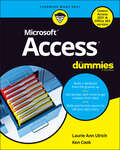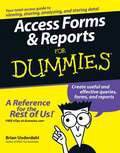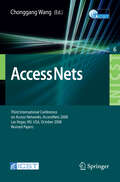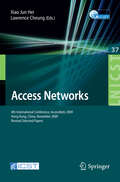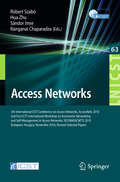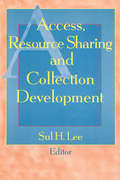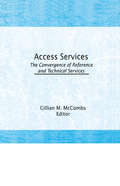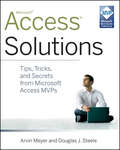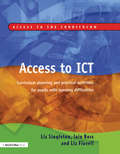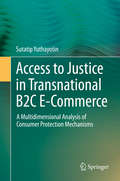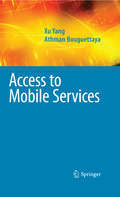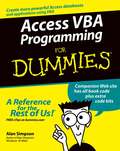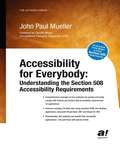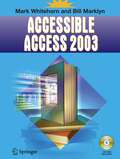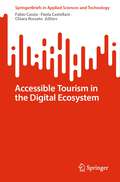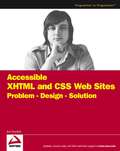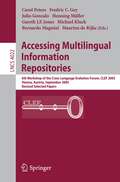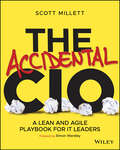- Table View
- List View
Access For Dummies
by Laurie A. Ulrich Ken CookBecome a database boss —and have fun doing it—with this accessible and easy-to-follow guide to Microsoft Access Databases hold the key to organizing and accessing all your data in one convenient place. And you don’t have to be a data science wizard to build, populate, and organize your own. With Microsoft Access For Dummies, you’ll learn to use the latest version of Microsoft’s Access software to power your database needs. Need to understand the essentials before diving in? Check out our Basic Training in Part 1 where we teach you how to navigate the Access workspace and explore the foundations of databases. Ready for more advanced tutorials? Skip right to the sections on Data Management, Queries, or Reporting where we walk you through Access’s more sophisticated capabilities. Not sure if you have Access via Office 2021 or Office 365? No worries – this book covers Access now matter how you access it. The book also shows you how to: Handle the most common problems that Access users encounter Import, export, and automatically edit data to populate your next database Write powerful and accurate queries to find exactly what you’re looking for, exactly when you need it Microsoft Access For Dummies is the perfect resource for anyone expected to understand, use, or administer Access databases at the workplace, classroom, or any other data-driven destination.
Access For Dummies
by Laurie A. Ulrich Ken CookBecome a database boss —and have fun doing it—with this accessible and easy-to-follow guide to Microsoft Access Databases hold the key to organizing and accessing all your data in one convenient place. And you don’t have to be a data science wizard to build, populate, and organize your own. With Microsoft Access For Dummies, you’ll learn to use the latest version of Microsoft’s Access software to power your database needs. Need to understand the essentials before diving in? Check out our Basic Training in Part 1 where we teach you how to navigate the Access workspace and explore the foundations of databases. Ready for more advanced tutorials? Skip right to the sections on Data Management, Queries, or Reporting where we walk you through Access’s more sophisticated capabilities. Not sure if you have Access via Office 2021 or Office 365? No worries – this book covers Access now matter how you access it. The book also shows you how to: Handle the most common problems that Access users encounter Import, export, and automatically edit data to populate your next database Write powerful and accurate queries to find exactly what you’re looking for, exactly when you need it Microsoft Access For Dummies is the perfect resource for anyone expected to understand, use, or administer Access databases at the workplace, classroom, or any other data-driven destination.
Access Forms and Reports For Dummies
by Brian UnderdahlCreate queries that make forms and reports useful Develop forms to access the data you need and make reports that make sense! If you thought you had to use a spreadsheet program to produce reports and forms, guess what! Access can turn out great-looking forms and reports that actually show what's going on with your data -- if you know how to ask it nicely. This hands-on guide helps you do just that, and it works with all versions of Access. Discover how to * Ask Access the right questions * Work with sets of data * Create simple forms with a wizard * Use queries to create new tables * Troubleshoot queries * Add visual features to reports
Access Nets: Third International Conference on Access Networks, AccessNets 2008, Las Vegas, NV, USA, October 15-17, 2008. Revised Papers (Lecture Notes of the Institute for Computer Sciences, Social Informatics and Telecommunications Engineering #6)
by Chonggang WangThe annual International Conference on Access Networks (AccessNets) aims to provide a forum that brings together researchers and scientists from academia as well as man- ers and engineers from industry to meet and exchange ideas and recent work on all aspects of access networks. AccessNets 2008 was the third edition of this event, which was successfully held in Las Vegas, Nevada, USA, during October 15–17, 2008. The conference consisted of two keynote addresses, five invited talks, seven technical sessions, and two panel sessions. Leonid Kazovsky from Stanford University and Kevin Schneider, Chief Technology Officer of ADTRAN, delivered their exciting keynote - dresses on “Future Evolution of Broadband Access,” and “Carrier Ethernet and the Evo- ing Access Networks,” respectively. Maurice Gagnaire, Martin Reisslein, Martin Maier, Paolo Giacomazzi, and John M. Cioffi gave interesting invited talks on different research topics on access networks. The technical papers presented original and fundamental - search advances in the area of access networks, while the panels focused on the interesting topics of “Fiber Assisted Wireless for Broadband Access Networks and Dynamic Spectrum Management (DSM) Successes. ” These conference proceedings include all the technical papers that were presented at AccessNets 2008. We hope that it will become a useful reference for researchers and practitioners working in the area of access networks.
Access Networks: 4th International Conference, AccessNets 2009, Hong Kong, China, November 1-3, 2009, Revised Selected Papers (Lecture Notes of the Institute for Computer Sciences, Social Informatics and Telecommunications Engineering #37)
by Xiao Jun Hei Lawrence CheungWith the rapid growth of the Internet as well as the increasing demand for broadband services, access networks have been receiving growing investments in recent years. This has led to a massive network deployment with the goal of eliminating the ba- width bottleneck between end-users and the network core. Today many diverse te- nologies are being used to provide broadband access to end users. The architecture and performance of the access segment (local loop, wired and wireless access n- works, and even home networks) are getting increasing attention for ensuring quality of service of diverse broadband applications. Moreover, most access lines will no longer terminate on a single device, thus leading to the necessity of having a home network designed for applications that transcend simple Internet access sharing among multiple personal computers and enable multimedia support. Therefore, the access network and its home portion have become a hot investment pool from both a fin- cial as well as a research perspective. The aim of the annual International Conference on Access Networks (AccessNets) is to provide a forum that brings together scientists and researchers from academia as well as managers and engineers from the industry and government organizations to meet and exchange ideas and recent work on all aspects of access networks and how they integrate with their in-home counterparts. After Athens in 2006, Ottawa in 2007, and Las Vegas in 2008, this year AccessNets moved to Asia for the first time.
Access Networks: 5th International ICST Conference on Access Networks, AccessNets 2010 and First International Workshop on Automatic Networking and Self-Management in Access Networks, SELFMAGICNETS 2010, Revised Selected Papers, Budapest, Hungary, November 3-5, 2010 (Lecture Notes of the Institute for Computer Sciences, Social Informatics and Telecommunications Engineering #63)
by Hua Zhu Sándor Imre Ranganai Chaparadza Robert SzabóThis book constitutes the reviewed post-proceedings of the 5th International ICST Conference on Access Networks, AccessNets 2010, and of the satellite event , the First International ICST Workshop on Autonomic Networking and Self-Management in Access Networks, SELFMAGICNETS 2010, held jointly in Budapest, Hungary in November 2010. The 19 revised full papers presented together with one invited paper and four poster papers were carefully reviewed and selected for inclusion in the proceedings. The papers are organized in topical sections on next generation wireless networks, emerging applications, next-generation broadband networks and autonomic networking and network self-management.
Access, Resource Sharing and Collection Development
by Sul H LeeAccess, Resource Sharing, and Collection Development explores the role of libraries in acquiring, storing, and disseminating information in different formats to help you better use technology to share scarce resources and connect library users with collections. With an expressed goal of encouraging continued debate and further investigation, this book provides you with developing strategies and procedures to meet the challenges you face as a collection development librarian during this dynamic time. Among the vital concerns addressed are the competition for limited resources, trends in document delivery, the evaluation of document delivery products, and libraries’options for the future.The chapters collected in Access, Resource Sharing, and Collection Development represent the proceedings of the annual conference held by the University of Oklahoma Libraries and the University of Oklahoma Foundation. The book provides insight into your peers’findings and ideas on: access vs. ownership the future role of the bibliographer changes in collection management managing restrained resource budgets an emphasis on the library user as customer the growth and acceptance of document delivery as a component of collection development and ILL electronic publishing and copyright issues commercial document delivery services Access, Resource Sharing, and Collection Development also shows you how to discover and evaluate "free" resources on the Internet, as standards for production, promotion, and maintenance are nonexistent. The challenge of using these materials is being met by developing criteria for selection, looking at cataloging options, and working in cooperation with other institutions. You’ll also learn the different options for document delivery and how to evaluate document delivery products. Among the book’s advice: you should consider the types of document delivery available, examine the benefits of combining outside services with in-house systems, review the criteria for selecting technologies and suppliers, and explore examples of institutions creating customized systems.
Access, Resource Sharing and Collection Development
by Sul H LeeAccess, Resource Sharing, and Collection Development explores the role of libraries in acquiring, storing, and disseminating information in different formats to help you better use technology to share scarce resources and connect library users with collections. With an expressed goal of encouraging continued debate and further investigation, this book provides you with developing strategies and procedures to meet the challenges you face as a collection development librarian during this dynamic time. Among the vital concerns addressed are the competition for limited resources, trends in document delivery, the evaluation of document delivery products, and libraries’options for the future.The chapters collected in Access, Resource Sharing, and Collection Development represent the proceedings of the annual conference held by the University of Oklahoma Libraries and the University of Oklahoma Foundation. The book provides insight into your peers’findings and ideas on: access vs. ownership the future role of the bibliographer changes in collection management managing restrained resource budgets an emphasis on the library user as customer the growth and acceptance of document delivery as a component of collection development and ILL electronic publishing and copyright issues commercial document delivery services Access, Resource Sharing, and Collection Development also shows you how to discover and evaluate "free" resources on the Internet, as standards for production, promotion, and maintenance are nonexistent. The challenge of using these materials is being met by developing criteria for selection, looking at cataloging options, and working in cooperation with other institutions. You’ll also learn the different options for document delivery and how to evaluate document delivery products. Among the book’s advice: you should consider the types of document delivery available, examine the benefits of combining outside services with in-house systems, review the criteria for selecting technologies and suppliers, and explore examples of institutions creating customized systems.
Access Services: The Convergence of Reference and Technical Services
by Gillian M. McCombsThis book takes a close look at the recent changing emphasis from collections to access, and from document description to document delivery. As the automation of library processes has moved from technical services to reference services, the roles of the professionals working in those capacities have changed dramatically. Library administrators who are looking to redeploy resources will gain helpful insights from the experiences of librarians who have already redirected their organizations. This helpful volume will be of tremendous assistance in redefining the traditional roles of reference and technical librarians. Access Services offers new insights into the movement from bibliographic access to information access that is reshaping reference services today. Informative discussions on topics such as cross-training experiments, revised organizational structures, the new role of the bibliographic utilities, library school education for the redefined professional, and changes in cataloging codes reveal what impact this trend has for librarians, services, and patrons.
Access Services: The Convergence of Reference and Technical Services
by Gillian M. McCombsThis book takes a close look at the recent changing emphasis from collections to access, and from document description to document delivery. As the automation of library processes has moved from technical services to reference services, the roles of the professionals working in those capacities have changed dramatically. Library administrators who are looking to redeploy resources will gain helpful insights from the experiences of librarians who have already redirected their organizations. This helpful volume will be of tremendous assistance in redefining the traditional roles of reference and technical librarians. Access Services offers new insights into the movement from bibliographic access to information access that is reshaping reference services today. Informative discussions on topics such as cross-training experiments, revised organizational structures, the new role of the bibliographic utilities, library school education for the redefined professional, and changes in cataloging codes reveal what impact this trend has for librarians, services, and patrons.
Access Solutions: Tips, Tricks, and Secrets from Microsoft Access MVPs
by Arvin Meyer Douglas J. SteeleTwo Microsoft Access MVPs show how you can become an Access power user Microsoft Access is the world’s leading database system, with millions of users and hundreds of thousands of developers. The best practices, tips, and techniques in this book can turn users into power users. Millions of eager users make Access the most popular database system in the world These Microsoft MVPs exploit key features in Access, providing advice on techniques for capturing, sharing and reporting Access data. Each tip provides detailed solutions with clear instructions for implementation, and samples of all can be found on the companion Web site Access 2010 Solutions offers professional advice that enables every Access user to get greater value from the Access database system.
Access Solutions: Tips, Tricks, and Secrets from Microsoft Access MVPs
by Arvin Meyer Douglas J. SteeleTwo Microsoft Access MVPs show how you can become an Access power user Microsoft Access is the world’s leading database system, with millions of users and hundreds of thousands of developers. The best practices, tips, and techniques in this book can turn users into power users. Millions of eager users make Access the most popular database system in the world These Microsoft MVPs exploit key features in Access, providing advice on techniques for capturing, sharing and reporting Access data. Each tip provides detailed solutions with clear instructions for implementation, and samples of all can be found on the companion Web site Access 2010 Solutions offers professional advice that enables every Access user to get greater value from the Access database system.
Access to ICT: Curriculum Planning and Practical Activities for Pupils with Learning Difficulties
by Liz Singleton Iain Ross Liz FlavellFirst Published in 2005. Routledge is an imprint of Taylor & Francis, an informa company.
Access to ICT: Curriculum Planning and Practical Activities for Pupils with Learning Difficulties
by Liz Singleton Iain Ross Liz FlavellFirst Published in 2005. Routledge is an imprint of Taylor & Francis, an informa company.
Access to Justice in Transnational B2C E-Commerce: A Multidimensional Analysis of Consumer Protection Mechanisms
by Sutatip YuthayotinThis book identifies institutional mechanisms that can be used to promote consumer confidence in direct online sales with businesses (B2C e-commerce). It argues that enhancing the access to justice in a multidimensional sense can potentially offer an effective means of boosting consumer confidence. It introduces a conceptual framework for a multidimensional approach to access to justice in the context of consumer protection, describing the various reasonable criteria needed to satisfy consumer demands in B2C e-commerce. The framework, which reflects all essential aspects of consumers’ expectations when they engage in online transactions, provides a benchmark for the evaluation of various consumer protection mechanisms. Based on an analysis of different mechanisms and using the framework’s criteria, the practice of private ordering, which does not rely on the creation of rules of law but rather on the use of technology as a solution, appears to offer a meaningful way to enhance access to justice in B2C e-commerce. However, though private ordering holds considerable potential, certain weaknesses still need to be eliminated. This book demonstrates how private ordering can be successfully implemented with the help of an intermediary, a neutral third party that plays an integral part in the collaborative task of facilitating various aspects of private ordering, thus helping to limit the risks of failure and ensuring a fairer market setting. In order to move forward, it argues that the state, with its wealth of material resources and incentive options, is the institution best suited to acting as an intermediary in facilitating private ordering. This promising proposal can improve consumer protection, which will in turn boost consumer confidence.
Access to Mobile Services (Advances in Database Systems #38)
by Xu Yang Athman BouguettayaAccess to Mobile Services focuses on methods for accessing broadcast based M-services from multiple wireless channels. This book presents a novel infrastructure that provides a multi-channel broadcast framework for mobile users to effectively discover and access composite M-services. Multi-channel algorithms are proposed for efficiently accessing composite services. Access to Mobile Services provides an in-depth survey of wireless data access and motivates the need to treat mobile services differently. A wireless adaptation of Service Oriented Architecture (SOA) is also covered. Designed for researchers and practitioners who work in the general area of mobile services, this book is also suitable for advanced-level students in computer science. Forewords by: Michael P. Papazoglou, Tilburg University, The NetherlandsFabio Casati, University of Trento, Italy
Access to Online Resources: A Guide for the Modern Librarian
by Kristina BotyriuteThis book is published open access under a CC BY 4.0 licence.The book offers a concise guide for librarians, helping them understand the challenges, processes and technologies involved in managing access to online resources. After an introduction the book presents cases of general authentication and authorisation. It helps readers understand web based authentication and provides the fundamentals of IP address recognition in an easy to understand manner. A special chapter is dedicated to Security Assertion Markup Language (SAML), followed by an overview of the key concepts of OpenID Connect. The book concludes with basic troubleshooting guidelines and recommendations for further assistance. Librarians will benefit from this quick and easy read, which demystifies the technologies used, features real-life scenarios, and explains how to competently employ authentication and access management.
Access VBA Programming For Dummies
by Alan SimpsonThis friendly, easy-to-use guide shows experienced Access users how to use VBA (Visual Basic for Applications) to build Access databases and applications, but also covers programming fundamentals for nonprogrammers Includes practical, ready-to-use VBA code examples that readers can type or copy and paste from the Web into their own database projects Explains basic VBA skills and concepts for nonprogrammers, such as procedures, variables, and loops Covers more advanced topics, such as record sets and other programming activities that are unique to Access programming Author has written more than ninety computer books and has been working with databases since the early 1980s
Accessibility for Everybody: Understanding the Section 508 Accessibility Requirements
by John MuellerIn today's rapidly changing technological world, it is increasingly important that web and desktop applications be accessible to everyone, including those of us with special needs. However, the legal requirements for accessibility are often convoluted and diffucult to understand, making it impossible for most developers to comply with the laws. In the first book on the market to address the topic, Author John Paul Mueller leads you through the maze of Section 508—the congressional law ensuring that all Americans have access to information technology—and offers comprehensive guidance on how to quickly and easily update your applications to conform to Section 508 requirements. To begin, Mueller outlines the Section 508 requirements that are relevant to web and desktop application developers, and explains the laws in language you can understand. Using extensive and varied program examples, Mueller continues on to teach you to write web and desktop applications that not only conform to Section 508 standards, but look forward to ensure long-term universal accessibility for all types of computer users. Specific topics include writing accessible web applications and desktop applications using Visual Basic .NET and Visual C# .NET, developing special application capabilities, using Microsoft and other third-party tools to develop accessible features, developing accessible scripting solutions, and more. The book even includes a directory of helpful organizations, agencies, and resources to help you with any further accessibility concerns you may have.
Accessible Access 2003
by Mark Whitehorn Bill MarklynThisiswherewetrytoconvinceyoutobuythisbook,tellyouwhatittriestodo, define a few terms and generally set the scene – all of which makes this more like an introduction than a first chapter, but no-one reads introductions so we called it a chapter. If you have already bought the book and know what it does, feel free to skip to Chapter 2 where the action starts. Whyshouldyoubuythisbook? TherearemanyAccessbooksonthemarket,whyshouldIbuythisone?Doesithavemore informationthananyotherbook? Errr, no, it actually has less than the big reference books you’ll also find on the shelf. So,isitverycheap? Well, it isn’t as expensive as some but, no, it isn’t particularly cheap either. Tobebrutallyfrank,you’renotdoingagreatjobofsellingthistome. Right, time for the hard sell. Bill worked for Microsoft as the Development Manager for the first three versions of Access. I (Mark) work as a database consultant, teach database theory and practice at two Universities and have written the UK Personal ComputerWorld’s database column for more than ten years. We met (at a database conference, not unreasonably, given our interests) in the summer before Access 1. 0 was launched and found that we shared similar views on how databases should be designed and built. Since then we have writtenabooktogetherabouttherelationalmodelthatunderliesAccessandall other relational database systems (see below for the inevitable plug). But why write a book about Access itself when there are already so many around? 3 1 Introduction Well, since Bill was in charge of the product’s development, it was fair to assume that we had the technical side reasonably well covered.
Accessible E-Content Creation Standards and Guidelines
by Bookshare XrcvcThis document/book lists the standards of and provides guidelines on creating accessible e-content from Mircosoft Word. These standards are intended to help NGOs, libraries, book production agencies and volunteers prepare a digital copy of books in Microsoft Word with a view to further convert it to accessible formats such as EPUB, accessible PDF and DAISY formats with minimal modifications.
Accessible Tourism in the Digital Ecosystem (SpringerBriefs in Applied Sciences and Technology)
by Fabio Cassia Paola Castellani Chiara RossatoThis book explores the growing demand for accessible tourism experiences and demonstrates how the perspective of digital ecosystems can play a vital role in creating more inclusive destinations. Through a combination of conceptual arguments and real-world case studies, the book sheds light on the practical aspects of accessible tourism. Statistics reveal that over one billion people have severe or moderate disabilities, emphasizing the urgent need for enhanced accessibility in tourism. However, both industry practices and academic research in this field are still lagging behind. The book highlights the challenge of establishing coordination among various stakeholders, including transport operators, hospitality firms, and public authorities, which has hindered the design and implementation of inclusive tourism experiences. By harnessing the power of new technologies, the book illustrates how digital ecosystems can effectively facilitate accessible tourism. It examines the demand for such experiences and demonstrates how embracing a digital ecosystem perspective can contribute to the development of more accessible tourism destinations. In addition to its theoretical insights, the book delves into several practical case studies that showcase successful examples of accessible tourism.
Accessible XHTML and CSS Web Sites: Problem - Design - Solution
by Jon DuckettShows Web developers how to make the transition from HTML to XHTML, an XML-based reformulation of HTML that offers greater design flexibility Demonstrates how to work with CSS (Cascading Style Sheets)-now supported by ninety percent of browsers and integral to new site-building tools from Macromedia and others-and implement a consistent style throughout and entire site Explains how to make a site accessible to people with impaired vision, limited hand use, dyslexia, and other issues-now a legal requirement for many sites in the U.S. and the U.K.
Accessing Multilingual Information Repositories: 6th Workshop of the Cross-Language Evaluation Forum, CLEF 2005, Vienna, Austria, 21-23 September, 2005, Revised Selected Papers (Lecture Notes in Computer Science #4022)
by Fredric Gey Julio Gonzalo Henning Mueller Gareh Jones Michael Kluck Bernardo Magnini Maarten De RijkeThis book constitutes the thoroughly refereed postproceedings of the 6th Workshop of the Cross-Language Evaluation Forum, CLEF 2005. The book presents 111 revised papers together with an introduction. Topical sections include multilingual textual document retrieval, cross-language and more, monolingual experiments, domain-specific information retrieval, interactive cross-language information retrieval, multiple language question answering, cross-language retrieval in image collections, cross-language speech retrieval, multilingual Web track, cross-language geographical retrieval, and evaluation issues.
The Accidental CIO: A Lean and Agile Playbook for IT Leaders
by Scott MillettAn indispensable guide showing IT leaders the way to balance the needs of innovation and exploration with exploitation and operational reliability Many books on modern IT leadership focus solely on supporting innovation and disruption. In practice these must be balanced with the need to support waste reduction in existing processes and capabilities while keeping the foundation operational, secure, compliant with regulations, and cost effective. In The Accidental CIO, veteran software developer-turned-executive Scott Millett delivers an essential playbook to becoming an impactful, strategic leader at any stage of your IT leadership journey from your earliest aspirations to long time incumbents in director and C-suite roles. You’ll find a wealth of hands-on advice for tackling the many challenges and paradoxes that face technology leaders, from creating an aligned IT strategy, defining a target architecture, designing a balanced operating model, and leading teams and executing strategy. After the foreword from Simon Wardley, The Accidental CIO will help you: Understand problem contexts you will face using the Cynefin decision making framework, and how the philosophies of agile, lean and design thinking can help manage them. Design an adaptive and strategically aligned operating model by applying the appropriate ways of working and governance approaches depending on each unique problem context. Organize a department using a blend of holacratic and hierarchical principles, and leveraging modern approaches such as Team Topology and Socio-technical patterns. Develop and deploy an effective and aligned IT Strategy using Wardley mapping based on a deep knowledge of your business architecture. With this knowledge you’ll be ready to create an empowered IT organization focused on solving customer problems and generating enterprise value. You’ll understand the science behind what motivates teams and changes behavior. And you’ll show your skills as a business leader thinking beyond IT outputs to impactful business outcomes.
